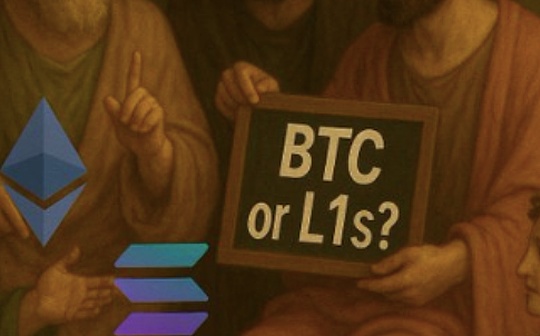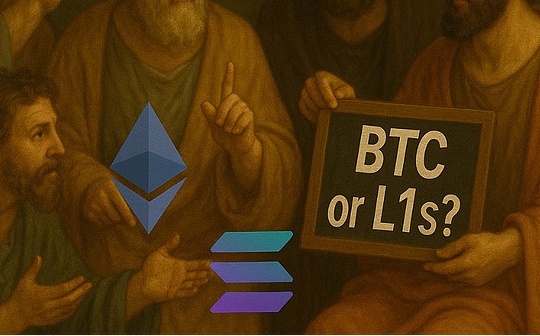
Author: ZEKE, YBB Capital researcher; Translation: Bit Chain Vision Xiaozou
In the era of modular blockchain led by Ethereum, it is no longer a novel concept to provide security services through integrated data availability (DA) layers.At present, the concept of sharing security is introduced through pledge, providing a new dimension in the field of modularity -using the potential of “digital gold and silver” to provide the security of cross -Bitcoin or Ethereum and many blockchain agreements and public chains.This narrative is quite magnificent, because it not only unlocks the liquidity of trillions of dollars of value assets, but also the key factor in future expansion solutions.For example, the recently raised $ 70 million and US $ 100 million in BABYLON and Ethereum pledge agreement, Babylon and Ethereum Re -Pickling Agreement, which allowed us to see the strong support of the leading venture capital companies in this field.
However, the development of these situations has also caused significant concerns.If modularization is the final expansion solution, and these protocols are the key components of the solution, they may lock a large number of BTC and ETH.This makes the security of the agreement itself the focus of people’s attention.Is the complex layered composed of many LSDs (liquidity pledge derivatives) and LRT (L2 Rollup tokens) protocols become the largest black swan in the blockchain in the future?Is their business logic reasonable?The discussion in this article will mainly focus on Babylon. After reading this article, you will solve the above doubts.
1. Expand safety consensus
Bitcoin and Ethereum are undoubtedly the most valuable public blockchain today.After years of accumulation of their security, decentralized characteristics, and value consensus, they are the key reasons for their core position of the blockchain world.These are rare quality that are difficult to copy other heterogeneous chains.The main idea of modularity is to “rent” these quality to those in need.The current field of modularization is mainly divided into two factions:
The first faction uses sufficiently safe L1 (usually Ethereum) as the functional layer or the most basic layer of ROLLUP.This solution provides the highest security and legitimacy, and can absorb resources from the main chain ecosystem.However, for specific ROLLUP (application chain, long tail chain, etc.), it may not be particularly friendly in throughput and cost.
The second faction aims to create a solution close to Bitcoin and Ethereum but has better cost -effectiveness, such as Celestia.Celestia achieves this by using pure DA function architecture, minimized node hardware demand and lower GAS costs.This simplified method is designed to create a DA layer that matches the security and decentralized characteristics of Ethereum, and at the same time provides strong performance in as short as possible.The disadvantage of this method is that its security and decentralization characteristics still take a period of time to fully develop, and lack legitimacy in the direct competition of Ethereum, which is rejected by the Ethereum community.
There are also the third types, such as Babylon and EIGENLAYER.它们利用权益证明(POS)核心概念,利用比特币或以太坊的资产价值来创建共享安全服务。Compared with the first two categories, this is a more neutral approach.Its advantage is that while inheriting the legitimacy and security, it also provides more practical value for the main chain assets, and provides higher flexibility.
2、数字黄金的潜力
Regardless of the underlying logic of any consensus mechanism, the security of the blockchain depends to a large extent on its underlying resources.The POW chain requires a lot of hardware and power support, while the POS chain depends on the value of pledge assets.比特币本身由一个非常大的PoW网络支持,使其成为整个区块链领域中最安全的链。然而,作为流通市值达1.39万亿美元(占区块链市场的一半)的公链,其资产效用主要局限于转移和gas支付。
On the other side of the blockchain world, especially after Ethereum transitions to the POS mechanism after the upgrade of Shanghai, it can be said that most public chains use various POS architecture to achieve consensus by default.However, new heterogeneous chains often cannot attract a large amount of capital pledge, which makes people doubt their security.In the current modularization era, COSMOS Zone and various L2 solutions can use various DA layers for compensation, but this is usually at the expense of autonomy.For most old POS mechanisms or alliance chains, it is usually impractical to use Ethereum or Celestia as the DA layer.The value of Babylon is to fill this gap for POS chain through BTC pledge.Just as humans use gold to support the value of banknotes, Bitcoin is very suitable for playing this role in the blockchain world.
3. From scratch
In the field of blockchain, the release of “digital gold” has always been the most ambitious but most difficult goal.From the early side chain, lightning network and bridge to the tokens to today’s Runes and BTC Layer 2, each solution has its inherent defects.If Babylon’s goal is to use the security of Bitcoin, then you must first rule out the centralized solution that introduces the assumption of third -party trust.In the remaining options, Runes and Lightning Networks (limited to extremely slow development progress) currently only have asset issuance capabilities.This means that babylon needs to design its own “expansion solution” to achieve native Bitcoin pledge from scratch.
The basic elements available to Bitcoin are basically the following: (1) UTXO model, (2) timestamp, (3) various signature methods, (4) basic operating code.In view of the limited programming and data carrying capacity of Bitcoin, Babylon’s solution is based on the principle of minimalism.在比特币上,只需要完成质押合约的基本功能,这意味着BTC质押、罚没、奖励和赎回都在主链上处理。一旦实现了从无到有,Cosmos Zone就可以处理更复杂的需求。然而,仍然存在一个关键问题:如何将PoS链数据记录到主链上?
4. Remote pledge
UTXO(未花费交易输出)是中本聪为比特币设计的交易模型。其核心思想非常简单:交易只是资金的进出,所以整个交易系统可以用输入和输出来表示。UTXO代表已进入但未完全支出的一部分资金,因此是未花费的交易输出(即未支付的比特币)。整个比特币账本本质上是UTXO的集合,记录每笔UTXO的状态,以管理比特币的所有权和流通。每笔交易都会花费旧的UTXO并生成新的UTXO。Due to its inherent extension potential, UTXO has naturally become the starting point of many native expansion solutions.For example, using UTXO and multiple signatures to create a punishment mechanism and status channel for Lightning Network, or bind UTXO to achieve semi -homogeneous tokens (SFT), such as inscriptions and Runes, all of which are derived from this key starting pointEssence
BABYLON also needs to use UTXO to achieve pledge contract (BABYLON calls remote pledge, of which the security of Bitcoin is transmitted to the POS chain through the intermediate remote).合约的实现巧妙地结合了现有操作码,可以分为四步:
Step 1: Locking funds
The user sends the funds to the address controlled by Multisig.Through OP_CTV (OP_CHECKTEMPLATEVERIFY, it supports the creation of pre -defined trading templates to ensure that transactions can only be executed in accordance with specific structures and conditions), and the contract can specify that these funds can only be used under certain conditions.Once the funds are locked, a new UTXO will be generated, indicating that these funds have been pledged.
Step 2: Conditional verification
By calling OP_CSV (OP_CHECKSEQUENCEVERIFY, it supports setting a relative time lock based on the transaction serial number, indicating that a UTXO can only be locked at a certain relative time or number of blocks).结合OP_CTV,可以实现质押、撤销质押(允许质押者在质押期满后花费锁定的UTXO)和罚没(如果质押者实施恶意行为,则会强制将UTXO花费转移到锁定地址,使其不可花费,类似In the black hole address).

Step 3: Status update
Whenever the user pledge or withdraws the pledge funds, it involves the creation and spending UTXO.The new transaction output generates a new UTXO, and the old UTXO is marked as the cost.In this way, each transaction and capital flow are accurately recorded on the blockchain to ensure transparency and security.
Step 4: Reward allocation
The contract calculates the reward based on the pledge amount and pledge time, and is distributed by generating a new UTXO.Once specific standards are reached, these rewards can be unlocked and expenditure through script conditions.
5. Time stamp
After the establishment of a native pledge contract, naturally considering the issue of historical events from the external chain.In Nakamoto’s white paper, the Bitcoin blockchain introduced the concept of timestamp supported by POW, providing an irreversible sequence for the event.In the native use cases of Bitcoin, these incidents refer to various transactions performed on the Bitcoin ledger.Today, in order to enhance the security of other POS chains, Bitcoin can also be used for event timestamps on external blockchains.Every time such an incident occurs, it triggers the transaction sent to the miner, and then the miner inserts it into the Bitcoin ledger to add a time stamp to the event.These timestamps can solve various security problems of the blockchain.The concept of adding time stamps to the event to the sub -chain on the mother chain is called “Checkpointing) and the transaction used to add time stamps is called the checkpoint transaction.Specifically, the timestamp in the Bitcoin blockchain has the following important features:
-
Time format:Time stamp records from UTC time at 00:00:00 on January 1, 1970. This format is called UNIX time or POSIX time.
-
Purpose:The main purpose of the timestamp is to mark the section of the block generation to help the node determine the order of the block and the difficulty adjustment mechanism of the auxiliary network.
-
Time stamp and difficulty adjustment:The Bitcoin network is difficult to adjust for mining every two weeks or every 2016 block.Time stamp plays a vital role in this process, because the network adjusts the difficulty based on the total generation time of the recent 2016 blocks to ensure that a new block is generated every 10 minutes.
-
Effective check:When a node receives a new block, it verifies the timestamp.The timestamp of the new block must be greater than the median time of the previous blocks, and it must not exceed 120 minutes (next 2 hours).
The time -stamp server is a new primitive defined by Babylon. It can allocate Bitcoin timestamp through the babylon checkpoint in the POS block to ensure the accuracy and non -degeneration of time sorting.The server is at the top of the entire Babylon architecture and is the core source of trust in trust.

6. Babylon’s three -layer architecture
As shown in the figure, the overall architecture of Babylon can be divided into three layers: Bitcoin as a timestamp server, a cosmos Zone as the middle layer -Babylon, and the POS chain as the demand layer.Babylon calls the latter two as Control Plane (Babylon itself) and Data Plane (various POS consumer chains).

After understanding the BABYLON protocol, we do not need to trust the realization of the Babylon protocol, let us study how Babylon itself uses Cosmos Zone to connect to both ends.According to the detailed explanation of Babylon’s TSE Laboratory of Stanford University, Babylon can receive checkpoint flow from multiple POS chains and merge these checkpoints and publish them to Bitcoin.By using the aggregation signature from Babylon verification, the scale of the checkpoint can be minimized, and the frequency of these checkpoints can only be controlled by restricting the BABYLON verification person per EPOCH.
Download BABYLON blocks from different POS chains to check whether the POS checkpoint is included in the Babylon block checked in Bitcoin.This enables the POS chain to detect deviations. For example, Babylon verifier creates a non -available block verified by Bitcoin and reports that it contains the POS checkpoint.The main components of the agreement are as follows:
-
Checking point:A Babylon Epoch will be verified by Bitcoin only the last block.The checkpoint consists of the hash value of the block and a BLS aggregation signature. The change of signature corresponds to the signature of two -thirds of the major verifications that have been signed by the final determination.Babylon checkpoint also includes the EPOCH number.POS blocks can allocate bitcoin timestamps through the babylon checkpoint.For example, the first two POS blocks are set up by the Babylon block, and the checkpoint is set by a bitcoin block with a timestamp to T_3.Therefore, these POS blocks will be assigned Bitcoin timestamp T_3.

-
Standardize POS chain:When the POS chain is fork, the early chain of the timestamp is considered to be a standard POS chain.If the two forks have the same timestamp, they tend to have POS blocks that have earlier checkpoints on Babylon.

-
A withdrawal rules:If you want to withdraw, the verification person needs to send a withdrawal request to the POS chain.The POS block containing the withdrawal request was then set up by Babylon, and then the checkpoint was set by Bitcoin, and the timestamp T_1 was allocated for it.Once the Bitcoin block with T_1 reaches the depth K, it will be authorized to withdraw money on the POS chain.If an authentication holding a withdrawal of withdrawal pledge attempts to conduct remote attacks, the block on the attack chain can only be assigned a time stamp at T_1.This is because the Bitcoin block with a timestamp of T_1 cannot roll back once it reaches the depth K.By observing the order of these checkpoints on the Bitcoin, the POS client can distinguish the norms and attack chains, and then ignore the latter.

-
No rules:If the verifications do not extract their pledge after the attack is detected, they may be cut because they have a POS block with dual signature conflicts.The malicious POS verifications know that if they wait for the withdrawal request to be approved before launching a long -range attack, they cannot deceive users who can refer to Bitcoin to identify the normative chain.Therefore, they may split the POS chain, and at the same time assign Bitcoin timestamp to blocks on the standard POS chain.These POS verifications and malicious BABYLON verifications and Bitcoin miners collude, replacing Babylon and Bitcoin forks, replaced the timestamp of the Bitcoin block of T_2 into another block with a timestamp to T_3.In the eyes of the POS client later, this will change the standard POS chain from the top chain to the bottom chain.Although this is a successful security attack, it has also led to the pledge of malicious POS verifications, because they have a dual signature conflict block without extracting pledge.

-
Do not use POS checkpoint pause rules:POS verifications must observe the unused POS checkpoint on Babylon and immediately suspend its POS chain.The hash value signed by two -thirds of the POS verifications cannot be used for POS checkpoints. The hash value is said to correspond to the POS block that cannot be observed.If the POS verifier does not stop the POS chain immediately after observing an unavailable checkpoint, then the attacker may expose the attack chain that is not available before, and change the norm chain for the later client.This is because the checkpoint of the shadow chain displayed late appeared earlier on Babylon.The above -mentioned suspension rules explain why we require the POS block hash values as a checkpoint to sign the POS verification.If these checkpoints are not signed, any attacker can send any hash values and claim that it is the hash value of the POS block checkpoint that is not available on Babylon.POS verifications must be suspended at the checkpoint.Please note that creating an unavailable POS chain is challenging: PoS authenticants that need at least two -thirds of POS verifications are required to sign the POS block without providing data to honest authenticants.However, in the assumed attack above, malicious attackers suspended the POS chain, but did not attack any verifications.In order to prevent such attacks, we require the POS checkpoint to sign by two -thirds of POS verifications.Therefore, unless two -thirds of the POS verifications are attacked, there will be no unavailable POS checkpoints on the babylon, because attacking POS verifications will not affect the cost of other POS chains or BABYLON itself, so a third of the thirdsThe situation of the POS authentication is basically impossible.
7. Eigenlayer in BTC
In terms of purpose, although Babylon is similar to Eigenlayer, it is far from the simple “bull” of Eigenlayer.Given that it is not currently unable to use DA on the BTC main chain, the existence of babylon is very important.This agreement not only brings security to the external POS chain, but also is also crucial to the revitalization of the BTC internal ecosystem.
Use case
There are many potential cases of babylon, some of which have been realized, or may have the opportunity to achieve in the future:
(1) Reduce pledge cycle and enhance safety:POS chain often requires social consensus (the consensus between communities, node operators and verifications) to prevent remote attacks.These attacks include rewriting blockchain history to manipulate transaction records or control chains.Remote attacks are particularly serious in the POS system, because unlike POW, the POS system does not need to be verified as a large amount of computing resources.The attacker can rewrite history by controlling the keys of early participants.In order to ensure the stability and security of the blockchain network consensus, a long pledge cycle is usually required.For example, COSMOS needs a 21 -day unbinding period.However, with the BABYLON, historical events of the POS chain can be included in the BTC timestamp server, and BTC can be used as a source of trust to replace social consensus.This can be shortened to one day (equivalent to about 100 BTC blocks).In addition, the POS chain can achieve dual security through native currency pledge and BTC pledge.

(2) Cross -chain interoperability:With the IBC protocol, Babylon can receive checkpoint data from multiple POS links to achieve cross -chain interoperability.This interoperability allows seamless communication and data sharing between different blockchain, thereby improving the overall efficiency and function of the blockchain ecosystem.
(3) Integrate BTC ecosystem:At present, most of the projects (including Layer 2, LRT, and DEFI) in BTC ecosystems lack sufficient security and usually depend on third -party trust assumptions.These protocols also store a large number of BTCs in their addresses.In the future, babylon may jointly develop some highly compatible solutions with these projects, mutual benefit and win -win, and eventually form a powerful ecosystem similar to Eigenlayer in Ethereum.
(4) Cross -chain asset management:The babylon protocol can be used for security management of cross -chain assets.By adding timestamps in cross -chain transactions, the safety and transparency of asset transfer between different blockchain can be ensured.This mechanism helps prevent double -flower attacks and other cross -chain attacks.
8. Babita
The story of Babetta comes from Chapter 11, 1-9 of the Bible · Creation. This is a classic story. It tells that humans try to build a tower to heaven, but they are frustrated by God.This story symbolizes human unity and fight for common goals.The Babylon protocol aims to build a similar tower for various POS chains and unify them under a roof.In terms of narrative, it seems no less than Eigenlayer, the defender of Ethereum.But how can it stand in practice?

So far, the BABYLON test network has provided security guarantee for 50 COSMOS ZONE through the IBC protocol.In addition to the COSMOS ecosystem, Babylon also integrates some LSD (liquidity pledge derivatives) protocol, full -chain interoperability protocol and bitcoin ecosystem protocol.However, in terms of pledge, Babylon is still behind Eigenlayer, and Eigenlayer can reuse pledge and LSD in the Ethereum ecosystem.However, in the long run, a large number of sleeping Bitcoin, which has been dormant in wallets and protocols, has not been completely awakened. This is only a corner of $ 1.3 trillion.Babylon needs to form a positive symbiotic relationship with the entire Bitcoin ecosystem.
(1) The only solution to Ponzi pledge difficulties
As mentioned earlier, both Eigenlayer and Babylon are developing rapidly, and future trends show that they will lock a large number of core blockchain assets.Even if these protocols are safe, will multi -layer pledge causing the pledged ecosystem into death spiral, causing another big collapse similar to the US interest rate hike?Since Ethereum transitions to the POS mechanism and Eigenlaeyr, the current pledge field has indeed undergone irrational prosperity.Each project usually attracts high TVL users through a large number of airdrop expectations and layered returns.ETH can be superimposed through native pledge, LSD and LRT, which are superimposed.This kind of baby -type operation increases risks, because as long as a protocol problem may directly affect all related protocols, especially those protocols at the end of the pledged chain.If this model is adopted, the Bitcoin ecosystem with many centralized solutions will face greater risks.
However, it should be noted that eigenlayer and babylon are fundamentally about guiding the pledged flying wheel to the real utility and creating real needs to resist risks.Therefore, although these “shared security” protocols may indirect or directly exacerbate bad behaviors, they are also the only ways to avoid the return of Ponzi in the sub -layer.The more urgent question is whether the business logic of the “Sharing Security” agreement is really feasible.
(2) Real needs are the key
In Web3, whether it is a public chain or an agreement, the underlying logic usually involves buyers and sellers with specific needs.The well -done projects can “win the world”, because blockchain technology ensures that the matching process is fair, authentic and credible.Theoretically, the shared security agreement can further supplement the booming pledge and modular ecosystem.However, will supply far exceed demand?At the supply side, many projects and main chains can provide modular security.At the demand side, the POS chain may not be required or unwilling to rent this security for face, and the new POS chain may be difficult to pay a large amount of interest generated by BTC and ETH.In order to enable Eigenlayer and Babylon to form a closed commercial cycle, the income generated must be able to balance the interest generated by the pledged token currency in the protocol.Even if this balance is achieved and income far exceeds interest expenses, these new POS chains and protocols may still be exhausted.Therefore, how to balance the economic model and avoid the bubble expected bubbles of airdrops, and to promote the relationship between supply and demand, it will be crucial.







